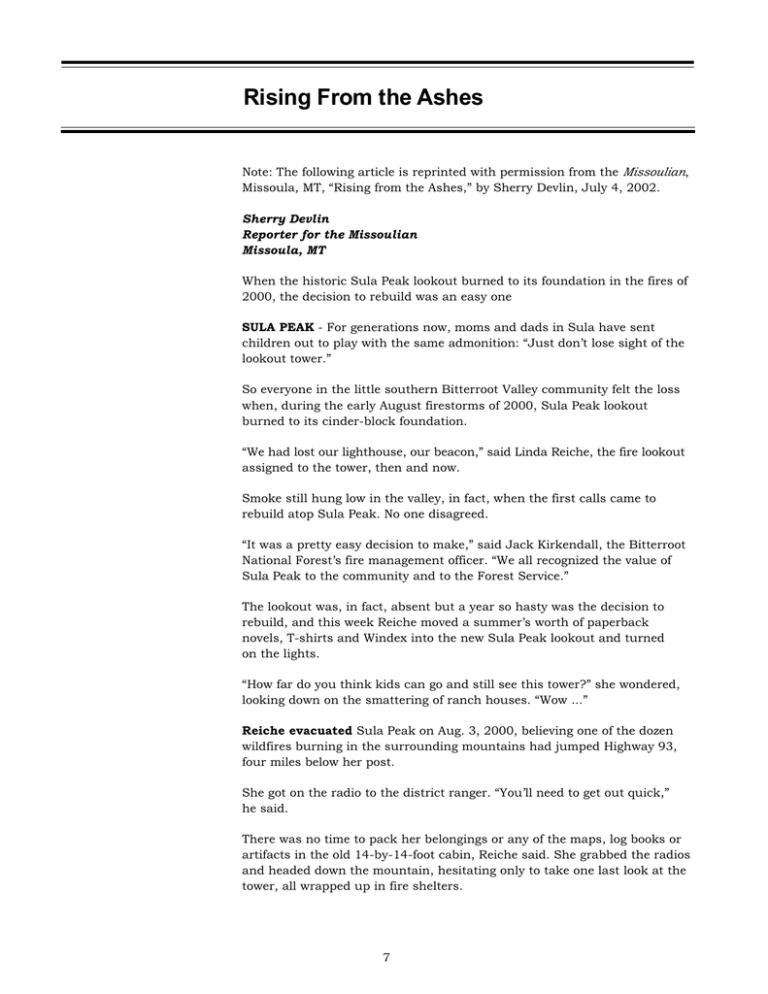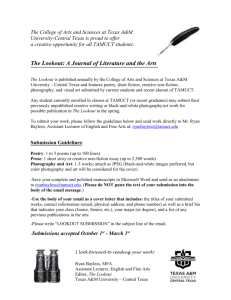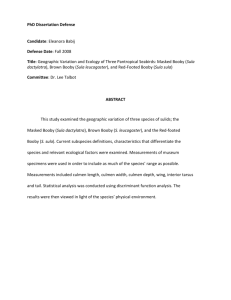Rising From the Ashes
advertisement

Rising From the Ashes Note: The following article is reprinted with permission from the Missoulian, Missoula, MT, “Rising from the Ashes,” by Sherry Devlin, July 4, 2002. Sherry Devlin Reporter for the Missoulian Missoula, MT When the historic Sula Peak lookout burned to its foundation in the fires of 2000, the decision to rebuild was an easy one SULA PEAK - For generations now, moms and dads in Sula have sent children out to play with the same admonition: “Just don’t lose sight of the lookout tower.” So everyone in the little southern Bitterroot Valley community felt the loss when, during the early August firestorms of 2000, Sula Peak lookout burned to its cinder-block foundation. “We had lost our lighthouse, our beacon,” said Linda Reiche, the fire lookout assigned to the tower, then and now. Smoke still hung low in the valley, in fact, when the first calls came to rebuild atop Sula Peak. No one disagreed. “It was a pretty easy decision to make,” said Jack Kirkendall, the Bitterroot National Forest’s fire management officer. “We all recognized the value of Sula Peak to the community and to the Forest Service.” The lookout was, in fact, absent but a year so hasty was the decision to rebuild, and this week Reiche moved a summer’s worth of paperback novels, T-shirts and Windex into the new Sula Peak lookout and turned on the lights. “How far do you think kids can go and still see this tower?” she wondered, looking down on the smattering of ranch houses. “Wow ...” Reiche evacuated Sula Peak on Aug. 3, 2000, believing one of the dozen wildfires burning in the surrounding mountains had jumped Highway 93, four miles below her post. She got on the radio to the district ranger. “You’ll need to get out quick,” he said. There was no time to pack her belongings or any of the maps, log books or artifacts in the old 14-by-14-foot cabin, Reiche said. She grabbed the radios and headed down the mountain, hesitating only to take one last look at the tower, all wrapped up in fire shelters. 7 “It won’t burn,” she thought. “There’s nothing up here but rocks.” Flames reached the peak Aug. 6, during a windstorm that pushed one wildfire into another and then another, creating a single mammoth fire that burned into September. Firefighters saw the building intact and untouched on the 6th, after the surrounding forest had burned to black. When they looked back on the 7th, it was gone. “I am thoroughly convinced that a spark got underneath the fire shelter,” Reiche said, “and since it had a shake roof and was a really old tinder-dry building, it only took one little spark and it was gone.” “It was hard to lose the building,” said Reiche, who has spent her summers in the Bitterroot forest’s 10 lookout towers since 1986. “All the old lookouts had written their names inside the drawers of the kitchen table. They had left little pieces of themselves up here - old maps and photographs and sentimental things. One lookout had labeled every feature on the horizon. Every drainage, every peak. Every bit of it was gone.” Sula Peak got its first lookout in the 1920s, a guard station that sat flat on the ground. In the 1930s, when Missoula architect Clyde Fickes designed the first hip-roofed, pre-packaged lookout, Sula Peak got one of the first square-timbered cabins - an “L-4” in Forest Service parlance. For 30 years, Sula’s L-4 sat atop a tower built of lodgepole timbers - Reiche calls them “stilts.” In the 1960s, the poles gave way to a sturdier cinderblock tower. When the order came to rebuild the Sula lookout, Forest Service architect Jane Kipp was told to copy Fickes’ 70-year-old design. But she had been in the old square cabins, “and there was just no room at all.” “I thought I should try to improve the fire lookout’s life a little,” Kipp said. “I thought they needed more windows and more space. And those old walkways around the outside were so tiny. I wanted to give them enough room for a deck chair. I just thought it would be nice.” Kipp started with a square, then rotated it. “And the rotation turned out to be eight-sided,” so she drew an octagonal cabin with “plenty of person room.” The resulting Sula Peak lookout is one-of-a-kind, an earth-toned top-knot that blends with the surrounding rocks. “I went up there and grabbed a pocket full of rocks, then went around to different places in town until I found matching concrete blocks for the tower and paint for the cabin,” Kipp said. Firefighters are a tradition-loving bunch, though, and Kipp saw more than a few raised eyebrows when she walked in with her eight-sided lookout. “Hey, this is an octagon,” they said. “Where’s the square?” “But no one said no, so I kept going,” said Kipp, who already has requests for blueprints of her design from Alberta and Idaho. 8 Reiche still kind of misses the old cabin and doesn’t quite know what to do with all the extra room. But her also-new dog, a Weimaraner named Bruno, loves the futon. And Reiche’s already positioned a pair of chairs on the wider-than-usual deck, with views to the rising sun. “Isn’t it a gorgeous building?” she asked. “The design is beautiful.” Inside, the cabin is all pine and glass. Bruce Bailey, who runs the union carpenter shop at Trapper Creek Job Corps, designed and built a new kitchen table, with a drawer where Reiche will renew the tradition by signing her name inside. A Bitterroot Valley rancher donated and milled a piece of pine for a new stand on which Reiche perched the Osborne Fire Finder she uses to locate each puff of smoke she spies. The Fire Finder itself came from an abandoned lookout tower on the Idaho Panhandle National Forest. “They don’t make these anymore,” she said. “They did some special things for me,” Reiche said. “They put a lot of little touches into this building - to bring it back for tradition.” And these days, it seems like everything’s coming back to Sula Peak. Nearly two years after the firestorm turned them to black, most of the pines and firs in forest below the lookout tower still stand. But it’s not the black, or even the leopard spots created by birds pecking the dead trees for insects, that catch the eye. It’s the green. The “ghost forest” - as Reiche christened it - is lush with new growth, thick with knee-high bunches of grass and a collection of wildflowers rarely seen in recent, drier years. Bitterroots are abundant on the rocky knobs just south of the tower. Mountain globemallow blooms in the draw. The blackened forest is loaded with Indian paintbrush, glacier lilies, lupines and miner’s lettuce. “What better job could there be than watching the wildflowers grow?” Reiche said, hopping from rock to rock to avoid the bitterroot bloom. “This is a great job,” she said. “I enjoy working by myself. It’s peaceful and quiet, and locating the fires is challenging. I don’t have a flush toilet or running water, and there’s a rattlesnake in the outhouse. But I get up in the morning and a lot of times there’ll be a band of sheep down there on the old trail. Or a band of rams. And sometimes I’ll see a black bear coming across the saddle. And I get to be a part of it all.” Besides, she said, “I’m never alone.” There’s always Bruno, lolling away the afternoon in the sun. And, of course, there are the children. All looking up at the lookout, from down below. 9 Reiche evacuated the old tower on August 3, 2000. By August 7, it was gone. Photo by Kurt Wilson/Missoulian “They put a lot of little touches in this building to bring it back for tradition” Photo by Kurt Wilson/Missoulian The Osborne Fire Finder in the new tower came from an abandoned lookout in the Idaho panhandle. Photo by Kurt Wilson/Missoulian 10





